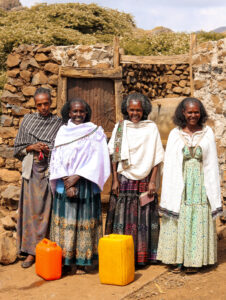System Strengthening: Working with Government
When external aid projects end, temporary services or improvements often disappear with them. The fundamental systems that should prevent problems from recurring remain weak. System Strengthening takes a different path. Rather than working around existing systems, such as market systems or governments, we work with them. The goal is simple: strengthen local capacity so that existing systems can deliver services effectively and independently.
What System Strengthening Looks Like
System strengthening means working with governments as partners, not bypassing them. It means embedding expertise within existing structures rather than creating parallel ones. It means measuring success by the capacity that remains in the system, and the improvements in the services they deliver, not just the services delivered directly by project.
In 2015, Ethiopia made one of Africa’s most ambitious child health commitments: to eliminate child stunting by 2030. With 38% of children under five affected by stunting (where children are too short for their age due to chronic malnutrition), this was an enormous challenge requiring coordinated action across health, water, agriculture, and education sectors.
Our Approach in Ethiopia
When we began working in Ethiopia, we aligned directly with the Seqota Declaration. Our Healthy Village Approach combines water, sanitation, nutrition, and maternal care to address the interconnected causes of child malnutrition. In Bangladesh, this approach helped reduce stunting five times faster than the national average. But simply replicating our model wouldn’t create lasting change. Instead, we asked: how can our expertise strengthen Ethiopia’s existing strategy?
 WASCHO members at watering point in Tigray, Ethiopia
WASCHO members at watering point in Tigray, Ethiopia
Contributing to National Strategy
Our staff work within woredas (districts) alongside government officials. When we train health and government workers on integrated approaches to child nutrition, those skills become permanent resources for their communities. When officials learn to use data for planning and budgeting, that capacity stays in the system.
Our work generates evidence that informs Ethiopia’s national approach. The Ministry of Health has been developing a “Malnutrition-Free Village” model that incorporates lessons from various partners, including our Healthy Village Approach. This isn’t just about scaling our programme, it’s about scaling into national systems by contributing to a government-led model that can be implemented nationally.
Why This Approach Works
- Scale: Government systems reach every community. When Ethiopia scales its national model, it can impact all 120 million citizens, not just specific project areas.
- Sustainability: Officials trained in integrated approaches keep using them after external programmes end. Digital systems embedded in government infrastructure continue generating data. Regular government budgets continue funding services.
- Resilience: Embedding approaches into existing systems means tools and skills remain in place, enabling services to continue even during disruption such as political change or climate shocks.
- Legitimacy: Communities trust services delivered through familiar government structures. Local officials champion approaches they helped develop.
 Linking and Learning Event in Addis Ababa, bringing together civil society, Government, and private sector working towards the Seqota Declaration.
Linking and Learning Event in Addis Ababa, bringing together civil society, Government, and private sector working towards the Seqota Declaration.
The Results
Ethiopia’s commitment is showing results. An impact study found significant improvements in regions where the Seqota Declaration’s Innovation Phase was implemented. Between 2016-2020, stunting was reduced by 15.5% and 18.5% in Amhara and Tigray respectively. The interventions prevented almost 1,031 child deaths and averted over 109,831 cases of stunting in the target woredas.
But the real measure of success isn’t just short-term outcomes. It’s the capacity that remains. Government officials continue using integrated approaches with new communities. Digital monitoring systems keep generating data for evidence-based planning. Policy frameworks guide ongoing resource allocation.
A Sustainable Path Forward
Ethiopia’s experience demonstrates what’s possible when external partners strengthen systems rather than replace them or work around them. This requires accepting government leadership, even when systems aren’t perfect. It means measuring success by capacity built and improvements in services delivered by the system, not just services delivered by the project. It means being prepared to step back when systems can function independently.
The reward is impact that lasts. Children benefit not just during project cycles, but for generations as strengthened systems continue delivering results. We believe system strengthening is the only sustainable path to ending child malnutrition. External funding will always be limited. Government systems, when they work well, can serve everyone. Our role is to help make those systems work better for the children who need them most.
Learn more about our system strengthening approach and how we’re creating lasting change in child health.